Family Life Cycle
Learning Objectives: Family Life Cycle
- Identify the overarching individual objective or task of the family life cycle.
- Describe the phases of the family life cycle.
- Describe new parenthood.
- Identify the factors that affect adjustment to new parenthood.
- Explain changes in marital satisfaction across the family life cycle.
- Describe a common change in marital satisfaction that accompanies the “empty nest.”
- Describe changes in gender roles across the family life cycle.
- Describe the role of grandparents in the family life cycle.
- Describe the changes in family relationships during middle adulthood.
- Describe changes and concerns in relationships with aging parents.
The family life cycle is conventionally represented as a sequence of stages typical of many adults, moving from independence from the family of origin, through forming one’s own family unit, raising kids, and becoming grandparents. Of course, many people do not follow the traditional sequence or pattern shown in this conventional family life cycle. It can be useful to broaden our definition of family life so it includes all varieties of domestic arrangement. If we do, “family” encompasses most of our activities in adult life other than work, friendships, and me-time. For many people, close friends are considered part of family.
We know that some families involve intimate relationships and children, but there are also other important facets. Family life revolves around the home. An important aspect of life for every adult is where they live and who lives with them. Another aspect is “home-making”–cooking, cleaning, and maintenance. Who does what? Family life also involves doing things together and enjoying a sense of community. For most adults in most cultures, the primary organizing factor in their lives is family, hence, the phrase “family life.” Much of development during adulthood revolves around where a person finds themselves in the family life cycle, in terms of moving through a sequence of finding a partner, forming a household family unit, and having or not having and raising children.
Family life cycle patterns differ across cultures and subcultures, and shift with historical time. The overarching objective or task of the family life cycle is to create the life that fits and works for the individual, that is consistent with their personal characteristics and preferences, the life they want. Successful navigation of the family life cycle means finding a life that is personally meaningful and fulfilling for you and that works for the rest of your family (however constituted) as well.
Single Adulthood
Singlehood. Being single is the most common lifestyle for people in their early 20s, and there has been an increase in the number of adults choosing to remain single. In 1960, only about 1 in 10 adults age 25 or older had never been married, in 2012 that had risen to 1 in 5 (Wang & Parker, 2014). While just over half (53%) of unmarried adults say they would eventually like to get married, 32 percent are not sure, and 13 percent do not want to get married.
It is projected that by the time people who are currently young adults reach their mid-40s and 50s, almost 25% of them may never have married. The U.S. is not the only country to see a rise in the number of single adults. The table below lists some of the reasons young adults give for staying single. In addition, adults are marrying later in life, cohabitating, and raising children outside of marriage in greater numbers than in previous generations. Young adults also have other priorities, such as education, and establishing their careers.
Table 8.3 Reasons for Staying Single
| Have not met the right person | 30% |
| Do not have financial stability | 27% |
| Not ready to settle down | 22% |
| Too young to marry | 22% |
adapted from Lally & Valentine-French, 2019
Historical trends in lifestyles and priorities may be reflected in changes in attitudes about the importance of marriage. In a recent Pew Research survey of Americans, respondents were asked to indicate which of the following statements came closer to their own views:
- “Society is better off if people make marriage and having children a priority.”
- “Society is just as well off if people have priorities other than marriage and children.”
Slightly more adults endorsed the second statement (50%) than those who chose the first (46%), with the remainder either selecting neither, both equally, or not responding (Wang & Parker, 2014). Young adults age 18-29 were more likely to endorse this second view than adults age 30 to 49; 67% and 53% respectively. In contrast, those age 50 or older were more likely to endorse the first statement (53%).
Committed Relationships and Marriage
Cohabitation. In American society, as well as in a number of other cultures, cohabitation has become increasingly commonplace (Gurrentz, 2018). For many emerging adults, age 18-24, cohabitation has become more common than marriage, as can be seen in Figure 8.6 below. While marriage is still a more common living arrangement for those 25-34, cohabitation has increased, while marriage has declined, as can be seen in Figure 8.7. Gurrentz also found that cohabitation varies by socioeconomic status. Those who are married tend to have higher levels of education, and thus higher earnings, or earning potential.
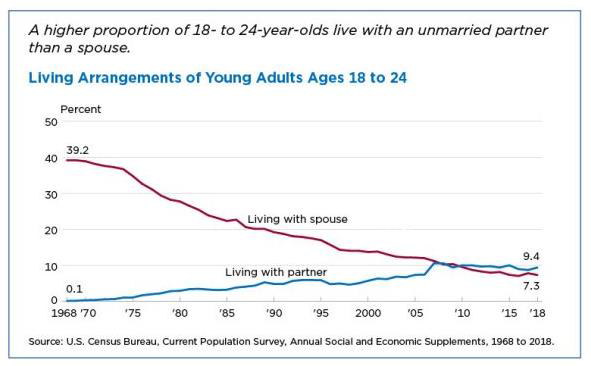
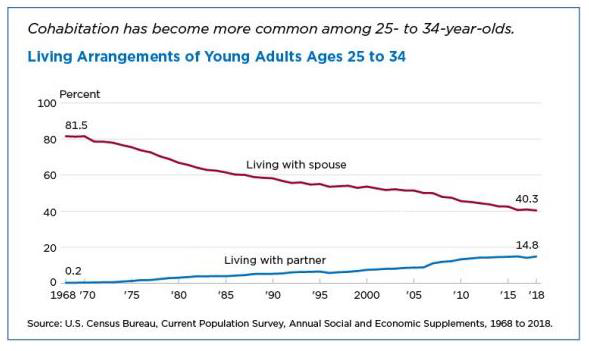
Copen, Daniels, and Mosher (2013) found that from 1995 to 2010 the median length of the cohabitation relationship had increased regardless of whether the relationship resulted in marriage, remained intact, or had since dissolved. In 1995 the median length of the cohabitation relationship was 13 months, whereas by 2010 it was 22 months. Cohabitation for all racial/ethnic groups, except for Asian women increased between 1995 and 2010 (see Table 8.4). Forty percent of the cohabitations transitioned into marriage within three years, 32% were still cohabitating, and 27% of cohabitating relationships had dissolved within the three years.
Table 8.4 Percentage of women by race/ethnicity whose first union was cohabitation
| 1995 | 2006-2010 | |
|---|---|---|
| Hispanic | 30% | 47% |
| White | 35% | 49% |
| Black | 35% | 49% |
| Asian | 22% | 22% |
adapted from Lally & Valentine-French, 2019
Based on data from Copen et al., 2013
Three explanations have been given for the rise of cohabitation in Western cultures. The first notes that the increase in individualism and secularism, and the resulting decline in religious observance, has led to greater acceptance and adoption of cohabitation (Lesthaeghe & Surkyn, 1988). Moreover, the more people observe couples cohabitating, the more normal this relationship seems, and the more couples will then cohabitate. Thus, cohabitation is both a cause and the effect of greater cohabitation.
A second explanation focuses on the economic changes. The growth of industry and the modernization of many cultures has improved women’s social status, leading to greater gender equality and sexual freedom, with marriage no longer being the only long-term relationship option (Bumpass, 1990). A final explanation suggests that changes in employment requirements, with many jobs now requiring more advanced education, has led to a delay in marriage while youth pursue post-secondary education (Yu & Xie, 2015). Since most people marry soon after they have competed their highest level of education (e.g., people who complete only high school generally marry at 18-19 years old whereas people who graduate college typically marry at age 24-25), this might account for the increase in the age of first marriage in many nations.
Taken together, the greater acceptance of premarital sex, and the economic and educational changes would lead to a transition in relationships. Overall, cohabitation may become a step in the courtship process or may, for some, replace marriage altogether. Similar increases in cohabitation have also occurred in other industrialized countries. For example, rates are high in Great Britain, Australia, Sweden, Denmark, and Finland. In fact, more children in Sweden are born to cohabiting couples than to married couples. The lowest rates of cohabitation in industrialized countries are in Ireland, Italy, and Japan (Benokraitis, 2005).
Cohabitation in Non-Western Cultures, the Philippines and China. Similar to other nations, young people in the Philippines are more likely to delay marriage, to cohabitate, and to engage in premarital sex as compared to previous generations (Williams, Kabamalan, & Ogena, 2007). Despite these changes, however, many young people are still not in favor of these practices. Moreover, there is still a persistence of traditional gender norms as there are stark differences in the acceptance of sexual behavior out of wedlock for men and women in Philippine society. Young men are given greater freedom. In China, young adults are cohabitating in higher numbers than in the past (Yu & Xie, 2015). Unlike many Western cultures, in China adults with higher, rather than lower, levels of education are more likely to cohabitate. Yu and Xie suggest this may be because cohabitation is seen as more “innovative” or “modern,” and that those who are more highly educated may have had more exposure to Western cultures.
Marriage Worldwide. Cohen (2013) reviewed data assessing most of the world’s countries and found that rates of marriage have declined universally during the last several decades. Although this decline has occurred in both poor and rich countries, the countries with the biggest drops in marriage were mostly rich: France, Italy, Germany, Japan and the U.S. Cohen argues that these declines are due not only to individuals delaying marriage, but also to higher rates of non-marital cohabitation. Delays or decreases in marriage are associated with higher income and lower fertility rates that are observed worldwide.
Marriage in the United States. In 1960, 72% of adults age 18 or older were married, in 2010 this number had dropped to barely half (Wang & Taylor, 2011). At the same time, the age of first marriage has been increasing for both men and women. In 1960, the average age for first marriage was 20 for women and 23 for men. By 2010 this had increased to 26.5 for women and nearly 29 for men (see Figure 8.8). Many of the explanations for increases in singlehood and cohabitation provided previously (especially increasing number of years of education) can also account for the drop and delay in marriage.
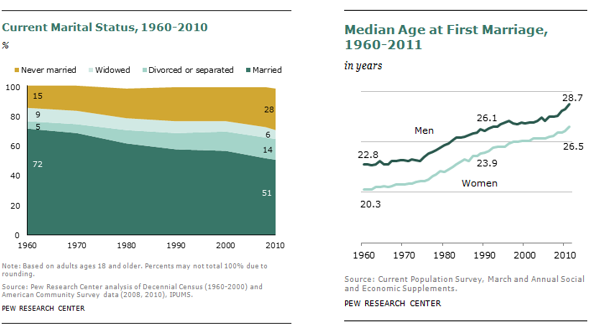

Same-Sex Marriage. In June 26, 2015, the United States Supreme Court ruled that the Constitution guarantees same-sex marriage. The decision indicated that limiting marriage to only heterosexual couples violated the 14th amendment’s guarantee of equal protection under the law. This ruling occurred 11 years after same-sex marriage was first made legal in Massachusetts, and at the time of the high court decision, 36 states and the District of Columbia had legalized same sex marriage. Worldwide, 29 countries currently have national laws allowing gays and lesbians to marry (Pew Research Center, 2019).
Cultural Influences on Marriage. Many cultures have both explicit and unstated rules that specify who is an appropriate mate. Consequently, mate selection is not completely left to the individual. Rules of endogamy indicate the groups we should marry within and those we should not (Witt, 2009). For example, many cultures specify that people marry within their own race, social class, age group, or religion. For example, for most of its history, the US upheld laws that criminalized marriage between people from different races; the last such laws were struck down by a Supreme Court ruling in 1967. Endogamy reinforces the cohesiveness of the group. Additionally, these rules encourage homogamy or marriage between people who share social characteristics. The majority of marriages in the U. S. are homogamous with respect to race, social class, age and to a lesser extent, religion. Homogamy is also seen in couples with similar personalities and interests.
Arranged Marriages and Elopement. Historically, marriage was not a personal choice, but one made by one’s family. Arranged marriages often ensured proper transference of a family’s wealth and the support of ethnic and religious customs. Such marriages were considered a marriage of families rather than of individuals. In Western Europe, starting in the 18th century, the notion of personal choice in a marital partner slowly became the norm. Arranged marriages were seen as “traditional” and marriages based on love “modern.” Many of these early “love” marriages were accomplished by eloping (Thornton, 2005).
Around the world, more and more young couples are choosing their own partners, even in nations where arranged marriages are still the norm, such as India and Pakistan. Desai and Andrist (2010) found that in India only 5% of the women they surveyed, aged 25-49, had a primary role in choosing their partner. Only 22% knew their partner for more than one month before they were married. However, the younger cohort of women was more likely to have been consulted by their families before their partner was chosen than were the older cohort, suggesting that family views are changing about personal choice. Allendorf (2013) reports that this 5% figure may also underestimate young people’s choice, as only women were surveyed. Many families in India are increasingly allowing sons veto power over the parents’ choice of his future spouse, and some families give daughters the same say.
Happiness and Marital Satisfaction. Although research frequently suggests that marriage is associated with higher rates of happiness, this does not guarantee that getting married will make you happy! The quality of one’s marriage matters greatly. When a person remains in a problematic marriage, it takes an emotional toll. Indeed, a large body of research shows that people’s overall life satisfaction is affected by their satisfaction with their marriage (Umberson, Williams, Powers, Chen, & Campbell, 2005; Proulx, Helms, & Buehler, 2007). Marital satisfaction has peaks and valleys during the course of the family life cycle. Rates of happiness are highest in the years prior to the birth of the first child. It hits a low point with the arrival of the second (or more) child. Children bring new demands and expectations to the marital relationship, along with more financial hardships and stress. Many people who are comfortable with their roles as partners find added parental duties and expectations more challenging to meet. Some couples elect not to have children, for a variety of reasons. These child-free couples, for example, may choose to focus more time and attention on their partners, careers, and interests.
Gender Role Changes. With the coming of the first child, gender roles in committed relationships typically become more traditional. In western countries, women often take on more domestic responsibilities and childrearing duties at this time (Cooke, 2010; Saginak & Saginak, 2005). for many women, this shift away from a largely egalitarian relationship may be one of the reasons that martial satisfaction suffers. The most egalitarian gender roles typically occur when children are older, and in the empty nest stage.
Parenthood
Parenthood is undergoing changes in the United States and elsewhere in the world. Women in the United States have fewer children than they did previously, and children are less likely to be living with both parents. The average fertility rate of women in the United States was about seven children in the early 1900s and has remained relatively stable at 2.1 since the 1970s (Hamilton, Martin, & Ventura, 2011; Martinez, Daniels, & Chandra, 2012). Not only are parents having fewer children, the context of parenthood has also changed. Parenting outside of marriage has increased dramatically among most socioeconomic, racial, and ethnic groups, although college-educated women are substantially more likely to be married at the birth of a child than are mothers with less education (Dye, 2010).
People are having children at older ages, too. This is not surprising given that many of the age markers for adulthood have been delayed, including marriage, completing an education, establishing oneself at work, and gaining financial independence. In 2014, the average age for American first-time mothers was 26.3 years (CDC, 2015). The birth rate for women in their early 20s has declined in recent years, while the birth rate for women in their late 30s has risen. In 2011, 40% of births were to women ages 30 and older. For Canadian women, birth rates are even higher for women in their late 30s than in their early 20s. In 2011, 52% of births were to women ages 30 and older, and the average first-time Canadian mother was 28.5 years old (Cohn, 2013). Improved birth control methods have also enabled women to postpone motherhood. Despite the fact that young people are more often delaying childbearing, most 18- to 29-year-olds want to have children and say that being a good parent is one of the most important things in life (Wang & Taylor, 2011).
Influences on Parenting. Parenting is a complex process in which parents and children influence one another. There are many reasons that parents behave the way they do. The multiple influences on parenting are still being explored. Proposed influences on parenting include: Parent characteristics, child characteristics, and contextual and sociocultural characteristics. (Belsky, 1984; Demick, 1999).

Parent Characteristics. Parents bring unique traits and qualities to the parenting relationship that affect their decisions as parents. These characteristics include the age of the parent, gender, beliefs, personality, developmental history, knowledge about parenting and child development, and mental and physical health. Parents’ personalities affect parenting behaviors. Mothers and fathers who are more agreeable, conscientious, and outgoing are warmer and provide more structure to their children. Parents who are more agreeable, less anxious, and less negative also support their children’s autonomy more than parents who are anxious and less agreeable (Prinzie, Stams, Dekovic, Reijntes, & Belsky, 2009). Parents who have these personality traits appear to be better able to respond to their children positively and provide a more consistent, structured environment for their children.
Parents’ developmental histories, or their experiences as children, also affect their parenting strategies. Parents may learn parenting practices from their own parents. Fathers whose own parents provided monitoring, consistent and age-appropriate discipline, and warmth were more likely to provide this constructive parenting to their own children (Kerr, Capaldi, Pears, & Owen, 2009). Patterns of negative parenting and ineffective discipline also appear from one generation to the next. However, parents who are dissatisfied with their own parents’ approach may be more likely to change their parenting methods with their own children.
Child Characteristics. Parenting is bidirectional. Not only do parents affect their children, children influence their parents. Child characteristics, such as gender, birth order, temperament, and health status, affect parenting behaviors and roles. For example, an infant with an easy temperament may enable parents to feel more effective, as they are easily able to soothe the child and elicit smiling and cooing. On the other hand, a cranky or fussy infant elicits fewer positive reactions from his or her parents and may result in parents feeling less effective in the parenting role (Eisenberg et al., 2008). Over time, parents of more difficult children may become more punitive and less patient with their children (Clark, Kochanska, & Ready, 2000; Eisenberg et al., 1999; Kiff, Lengua, & Zalewski, 2011). Parents who have a fussy, difficult child are less satisfied with their marriages and have greater challenges in balancing work and family roles (Hyde, Else-Quest, & Goldsmith, 2004). Thus, child temperament is one of the child characteristics that influences how parents behave with their children.
Another child characteristic is the gender of the child. Parents respond differently to boys and girls. Parents talk differently with their sons and daughters, providing more scientific explanations to their sons and using more emotion words with their daughters (Crowley, Callanan, Tenenbaum, & Allen, 2001). Parents also often assign different household chores to their sons and daughters. Girls are more often responsible for caring for younger siblings and household chores, whereas boys are more likely to be asked to perform chores outside the home, such as mowing the lawn (Grusec, goodnow, & Cohen, 1996).
Contextual Factors and Sociocultural Characteristics. The parent–child relationship does not occur in isolation. As we discussed in the previous section on families and parenting, parenting is influenced by higher-order sociocultural contexts. Sociocultural characteristics, including economic hardship, religion, politics, neighborhoods, schools, and social support, also influence parenting. Parents who experience economic hardship are more easily frustrated, depressed, and sad, and these emotional characteristics affect their parenting skills (Conger & Conger, 2002).
Culture also influences parenting behaviors in fundamental ways. Although promoting the development of skills necessary to function effectively in one’s community is a universal goal of parenting, the specific skills necessary vary widely from culture to culture. Thus, parents have different goals for their children that partially depend on their culture (Tamis-LeMonda et al., 2008). Parents vary in how much they emphasize goals for independence and individual achievements, maintaining harmonious relationships, and being embedded in a strong network of social relationships. Culture is also a contributing contextual factor. For example, Latina mothers who perceived their neighborhood as more dangerous showed less warmth with their children, perhaps because of the greater stress associated with living a threatening environment (Gonzales et al., 2011).
Other important contextual characteristics, such as the neighborhood, school, and social networks, also affect parenting, even though these settings do not always include both the child and the parent (Brofenbrenner, 1989). This would be a good time to go back and re-re the section in Unit 4: Family on higher-order contexts of parenting, and the two papers that examined the ways that poverty and structural racism make parenting more challenging. As you may remember, there are three major ways that status hierarchies, like those organized around class and race, make parenting more difficult:
- Inequities create objective living conditions that are developmentally hazardous to children and families;
- Hardships and discrimination force people to parent under stressful conditions; and
- Families must expend effort to counteract the pervasive effects of discrimination and prejudice on the development of their children and adolescents.
Pay special attention to the recommendations provided in that section about how to make higher-order contexts more supportive of the important jobs of parenting and providing for a family, which are challenging tasks even under the best of circumstances
The many factors that influence parenting are depicted in the following figure.

Family Life in Middle Adulthood
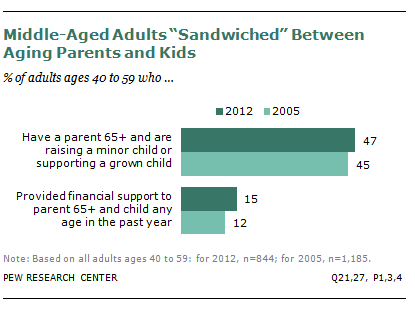
The sandwich generation refers to adults who have at least one parent age 65 or older and are either raising their own children or providing support for their grown children. According to a recent Pew Research survey, 47% of middle-aged adults are part of this sandwich generation (Parker & Patten, 2013). In addition, 15% of middle-aged adults are providing financial support to an older parent while raising or supporting their own children (see Figure 8.12). According to the same survey, almost half (48%) of middle-aged adults, have supported their adult children in the past year, and 27% are the primary source of support for their grown children.
Seventy-one percent of the sandwich generation is age 40-59, 19% were younger than 40, and 10% were 60 or older. Hispanics are more likely to find themselves supporting two generations: 31% have parents 65 or older and a dependent child, compared with 24% of whites and 21% of blacks (Parker & Patten, 2013). Women are more likely to take on the role of care provider for older parents in the U.S. and Germany (Pew Research, 2015). About 20% of women say they have helped with personal care, such as getting dressed or bathing, of aging parents in the past year, compared with 8% of men in the U.S. and 4% in Germany. In contrast, in Italy men are just as likely (25%) as women (26%) to have provided personal care.
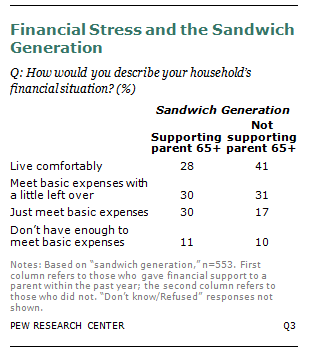
The Pew survey found that almost 33% of the sandwich-generation adults were more likely to say they always feel rushed, while only 23% of other adults said this. However, the survey suggests that those who were supporting both parents and children reported being just as happy as those middle-aged adults who did not find themselves in the sandwich generation (Parker & Patten, 2013). Adults who are supporting both parents and children did report greater financial strain (see Figure 8.13). Only 28% reported that they were living comfortably versus 41% of those who were not also supporting their parents. Almost 33% were just making ends meet, compared with 17% of those who did not have the additional financial burden of aging parents.
Empty nest. The empty nest, or post-parental period refers to the time period when children are grown up and have left home (Dennerstein, Dudley & Guthrie, 2002). For most parents this occurs during midlife. This time is recognized as a “normative event” as parents are aware that their children will become adults and eventually leave home (Mitchell & Lovegreen, 2009). The empty nest creates complex emotions, both positive and negative, for many parents. Some theorists suggest this is a time of role loss for parents, others suggest it is one of role strain relief (Bouchard, 2013).
The role loss hypothesis predicts that when people lose an important role in their life they experience a decrease in emotional well-being. It is from this perspective that the concept of the empty nest syndrome emerged, which refers to great emotional distress experienced by parents, typically mothers, after children have left home. The empty nest syndrome is linked to the absence of alternative roles for the parent in which they could establish their identity (Borland, 1982). In Bouchard’s (2013) review of the research, she found that few parents reported loneliness or a big sense of loss once all their children had left home.
In contrast, the role stress relief hypothesis suggests that the empty nest period should lead to more positive changes for parents, as the responsibility of raising children has been lifted. The role strain relief hypothesis was supported by many studies in Bouchard’s (2013) review. A consistent finding throughout the research literature is that raising children has a negative impact on the quality of martial relationships (Ahlborg, Misvaer, & Möller, 2009; Bouchard, 2013). Most studies report that martial satisfaction often increases during the launching phase of the empty nest period, and that this satisfaction endures long after the last child has left home (Gorchoff, John, & Helson, 2008).
However, most of the research on the post-parental period has been with American parents. A number of studies in China suggest that empty-nesters, especially in more rural areas of China, report greater loneliness and depression than their counterparts with children still at home (Wu et al., 2010). Family support for the elderly by their children is a cherished Chinese tradition (Wong & Leung, 2012). The fact that children move from the rural communities to the larger cities for education and employment may explain the more negative reaction of Chinese parents compared to American samples. The loss of an adult child in a rural region may mean a loss of family income and support for aging parents. Empty-nesters in urban regions of China did not report the same degree of distress (Su et al., 2012), suggesting that it not so much the event of children leaving, but the additional hardships this may place on aging parents.
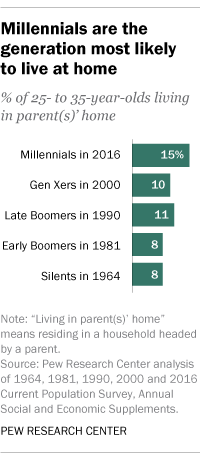
Boomerang Kids. Young adults are living with their parents for a longer duration and in greater numbers than previous generations. In addition to those in early adulthood who are not leaving the home of their parents, there are also boomerang kids, a term used to refer to young adults who return after having lived independently outside the home. The first Figure 8.14 shows the number of American young people 25-35 who were living at home based on their generation (Fry, 2017). The second Figure 8.15 with the European map, shows that more young adults 18-34 in Europe are also living with their parents (Desilver, 2016). Many of the same financial reasons that are influencing young people’s decisions to delay exit from the home of their parents are underlying their decisions to return home. In addition, to financial reasons, some boomerang kids are returning because of emotional distress, such as mental health issues (Sandberg-Thoma, Snyder, & Jang, 2015).
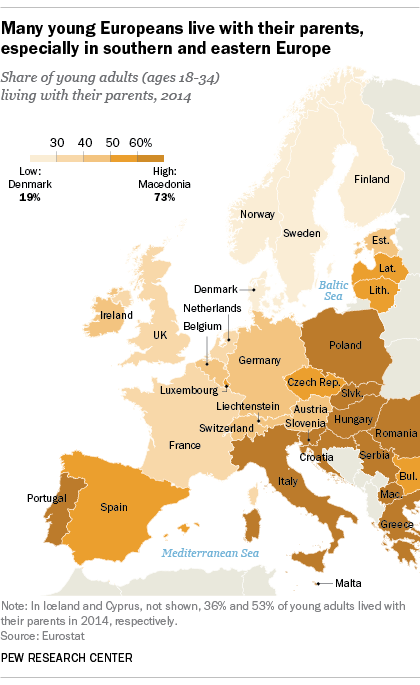
What is the effect on parents when their adult children return home? Certainly, there is considerable research that shows that the stress of raising children can have a negative impact on parents’ well-being, and that when children leave home many couples experience less stress and greater life satisfaction (see the section on the empty nest). Early research in the 1980s and 1990s supported the notion that boomerang children, along with those who were failing to exit the home, placed greater financial hardship on the parents, and the parents reported more negative perceptions of this living arrangement (Aquilino, 1991).
Recent surveys suggest that today’s parents are more tolerant of this, perhaps because this is becoming a more normative experience than in the past. Moreover, children who return are more likely to have had good relationships with their parents growing up, so there may be less stress between parents and their adult children who return (Sandberg-Thoma et al., 2015). Parents of young adults who have moved back home because of economic reasons report that they are just as satisfied with their life as are parents whose adult children are still living independently (Parker, 2012). Parker found that adult children age 25 and older are more likely to contribute financially to the family or complete chores and other household duties. Parker also found that living in a multigenerational household may be acting as an economic safety net for young adults. In comparison to young adults who were living outside of the home, those living with their parents were less likely to be living in poverty (17% versus 10%).
So far, we have considered the impact that adult children who have returned home or have yet to leave the nest have on the lives of middle-aged parents. What about the effect on parents who have adult children dealing with personal problems, such as alcoholism, chronic health concerns, mental health issues, trouble with the law, poor social relationships, or academic or job-related problems, even if they are not living at home? The life course perspective proposes the idea of linked lives (Greenfield & Marks, 2006). The notion that people in important relationships, such as children and parents, mutually influence each other’s developmental pathways. In previous chapters you have read about the effects that parents have on their children’s development, but this relationship is bidirectional. The problems faced by children, even when those children are adults, influence the lives of their parents. Greenfield and Marks found in their study of middle-aged parents and their adult children, those parents whose children were dealing with personal problems reported more negative affect, lower self-acceptance, poorer parent-child interactions, and more family relationship stress. The more problems the adult children were facing, the worse the lives and emotional health of their parents, with single parents faring the worst.
Committed Relationships in Middle Adulthood
Singlehood. According to a Pew Research study, 16 per 1,000 adults age 45 to 54 and 7 per 1000 age 55 and over have never-married in the U. S. (Wang & Parker, 2014). However, some of them may be living with a partner. In addition, some singles at midlife may be single through divorce or widowhood. DePaulo (2014) has challenged the idea that singles, especially the always single, fare worse emotionally and in health when compared to those married. DePaulo suggests there is a bias in how studies examine the benefits of marriage. Most studies focus on comparisons between married versus not married, which do not include a separate comparison between those always single, and those who are single because of divorce or widowhood. Her research has found that those who are married may be more satisfied with life than the divorced or widowed, but there is little difference between married and always single, especially when comparing those who are recently married with those who have been married for four or more years. It appears that once the initial blush of the honeymoon wears off, those who are wedded are no happier or healthier than those who remained single. This also suggests that it could be problematic for studies to consider the “married” category to be a homogeneous group.
Online Dating. Montenegro (2003) surveyed over 3,000 singles aged 40–69, and almost half of the participants reported their most important reason for dating was to have someone to talk to or do things with. Additionally, sexual fulfillment was also identified as an important goal for many. Alterovitz and Mendelsohn (2013) reviewed online personal ads for men and women over age 40 and found that romantic activities and sexual interests were mentioned at similar rates among the middle-age and young-old age groups, but less for the old-old age group.
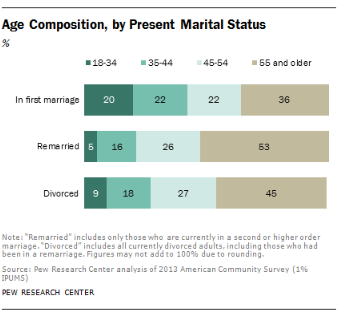
Marriage. Trends seen in early adulthood also show up in relationships during middle adulthood, including declines in the rate of marriage, as more people are cohabitating, more are deciding to stay single, and more are getting married at a later age. As you can see in the Figure 8.16, 48% of adults age 45-54 are married; either in their first marriage (22%) or have remarried (26%). This makes marriage the most common relationship status for middle-aged adults in the United States.
Marital satisfaction tends to increase for many couples in midlife as children are leaving home (Landsford, Antonucci, Akiyama, & Takahashi, 2005). Not all researchers agree. They suggest that those who are unhappy with their marriage are likely to have gotten divorced by now, making the quality of marriages later in life only look more satisfactory (Umberson, Williams, Powers, Chen, & Campbell, 2005).
Divorce. Livingston (2014) found that 27% of adults age 45 to 54 were divorced (see Figure 8.32). Additionally, 57% of divorced adults were women. This reflects the fact that men are more likely to remarry than are women. Two-thirds of divorces are initiated by women (AARP, 2009). Most divorces take place within the first 5 to 10 years of marriage. This time line reflects people’s initial attempts to salvage the relationship. After a few years of limited success, the couple may decide to end the marriage. It used to be that divorce after having been married for 20 or more years was rare, but in recent years the divorce rate among more long-term marriages has been increasing. Brown and Lin (2013) note that while the divorce rate in the U.S. has declined since the 1990s, the rate among those 50 and older has doubled.
They suggest several reasons for the “graying of divorce”. There is less stigma attached to divorce today than in the past. Some older women are out-earning their spouses, and thus may be more financially capable of supporting themselves, especially as most of their children have grown. Finally, given increases in human longevity, the prospect of living several more years or decades with an incompatible spouse may prompt middle-aged and older adults to leave the marriage. Gottman and Levenson (2000) found that divorces in early adulthood were angrier and more conflictual, with each partner blaming the other for the failures in the marriage. In contrast, they found that at midlife divorces tended to be more about having grown apart, or a cooling off of the relationship.
A survey by AARP (2009) found that men and women had diverse motivations for getting a divorce. Women reported concerns about the verbal and physical abusiveness of their partner (23%), drug/alcohol abuse (18%), and infidelity (17%). In contrast, men mentioned they had simply fallen out of love (17%), no longer shared interests or values (14%), and infidelity (14%). Both genders felt their marriage had been over long before the decision to divorce was made, with many of the middle-aged adults in the survey reporting that they stayed together because they were still raising children. Females also indicated that they remained in their marriage due to financial concerns, including the loss of health care (Sohn, 2015). However, only 1 in 4 adults regretted their decision to divorce.
The effects of divorce are varied. Overall, young adults struggle more with the consequences of divorce than do those at midlife, as they have a higher risk of depression or other signs of problems with psychological adjustment (Birditt & Antonucci, 2013). Divorce at midlife is more stressful for women. In the AARP (2009) survey, 44% of middle-aged women mentioned financial problems after divorcing their spouse; in comparison, only 11% of men reported such difficulties. However, a number of women who divorce in midlife report that they felt a great release from their day-to-day sense of unhappiness. Hetherington and Kelly (2002) found that among the divorce enhancers, those who had used the experience to better themselves and seek more productive intimate relationships, and the competent loners, those who used their divorce experience to grow emotionally, but who choose to stay single, the overwhelming majority were women.
Dating Post-Divorce. Most divorced adults have dated by one year after filing for divorce (Anderson et al., 2004; Anderson & Greene, 2011). One in four recent filers report having been in or were currently in a serious relationship, and over half were in a serious relationship by one year after filing for divorce. Not surprisingly, younger adults were more likely to be dating than were middle aged or older adults, no doubt due to the larger pool of potential partners from which they could to draw. Of course, these relationships will not all end in marriage. Teachman (2008) found that more than two thirds of women under the age of 45 had cohabited with a partner between their first and second marriages.
Dating for adults with children can be more of a challenge. Courtships are shorter in remarriage than in first marriages. When couples are “dating”, there is less going out and more time spent in activities at home or with the children. So, the couple gets less time together to focus on their relationship. Anxiety or memories of past relationships can also get in the way. As one Talmudic scholar suggests “when a divorced man marries a divorced woman, four go to bed” (Secombe & Warner, 2004).
Post-divorce parents gatekeep, that is, they regulate the flow of information about their new romantic partner to their children, in an attempt to balance their own needs for romance with consideration regarding the needs and reactions of their children. Anderson et al. (2004) found that almost half (47%) of dating parents gradually introduce their children to their dating partner, giving both their romantic partner and children time to adjust and get to know each other. Many parents who use this approach do so to protect their children from having to keep meeting someone new until it becomes clear that this relationship might be a lasting one. It might also help if the adult relationship is on firmer ground so it can weather any initial push back from children when it is revealed. Forty percent of people are open and transparent with their children about the new relationship right from the outset. Thirteen percent do not reveal the relationship until it is clear that cohabitation and or remarriage is likely. Anderson and colleagues suggest that practical matters influence which gatekeeping method parents may use. Parents may be able to successfully shield their children from a parade of partners if there is reliable childcare available. The age and temperament of the child, along with concerns about the reaction of the ex-spouse, may also influence when parents reveal their romantic relationships to their children.
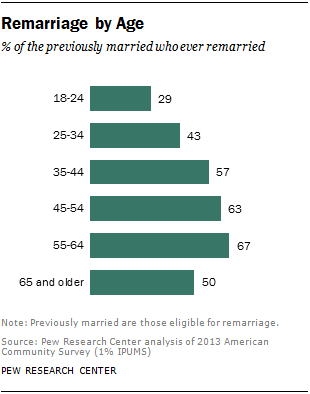
Rates of re-marriage. The rate for remarriage, like the rate for marriage, has been declining overall. In 2013 the remarriage rate was approximately 28 per 1,000 adults 18 and older. This represents a 44% decline since 1990 and a 16% decline since 2008 (Payne, 2015). Brown and Lin (2013) found that the rate of remarriage dropped more for younger adults than middle aged and older adults, and Livingston (2014) found that as we age, we are more likely to have remarried (see Figure 8.17). This is not surprising as it takes some time to marry, divorce, and then find someone else to marry. However, Livingston found that unlike those younger than 55, those 55 and up are remarrying at a higher rate than in the past. In 2013, 67% of adults 55-64 and 50% of adults 65 and older had remarried, up from 55% and 34% in 1960, respectively.
Men have a higher rate of remarriage at every age group starting at age 25 (Payne, 2015). Livingston (2014) reported that in 2013, 64% of divorced or widowed men compared with 52% of divorced or widowed women had remarried. However, this gender gap has narrowed over time. Even though more men still remarry, they are remarrying at a slower rate. In contrast, women are remarrying today more than they did in 1980. This gender gap has closed mostly among young and middle-aged adults, but still persists among those 65 and older.
In 2012, Whites who were previously married were more likely to remarry than were other racial and ethnic groups (Livingston, 2014). Moreover, the rate of remarriage has increased among Whites, while the rate of remarriage has declined for other racial and ethnic groups. This increase is driven by White women, whose rate of remarriage has increased, while the rate for White males has declined.

Success of Re-marriage. Research is mixed as to the happiness and success of remarriages. While some remarriages are more successful, especially if the divorce motivated the adult to engage in self-improvement and personal growth (Hetherington & Kelly, 2002), a number of divorced adults end up in very similar marriages the second or third time around (Hetherington & Kelly, 2002). Remarriages have challenges not found in first marriages and they can create additional stress in the marital relationship.
There can also be a general lack of clarity in family roles and expectations when trying to incorporate new kin into the family structure. Even determining the appropriate terms for these kin, along with their roles, can be a challenge. Partners may have to carefully navigate their role when dealing with their partners’ children. All of this may lead to greater dissatisfaction and even resentment among family members. Even though remarried couples tend to have more realistic expectations for marriage, they tend to be less willing to stay in unhappy situations. The rate of divorce among remarriages is higher than among first marriages (Payne, 2015), which can add additional burdens, especially when children are involved.
Children’s Influence on Re-partnering. Do children affect whether a parent remarries? Goldscheider and Sassler (2006) found children residing with their mothers reduces the mothers’ likelihood of marriage, only with respect to marrying a man without children. Further, having children in the home appears to increase single men’s likelihood of marrying a woman with children (Stewart, Manning, & Smock, 2003). There is also some evidence that individuals who participated in a stepfamily while growing up may feel better prepared for stepfamily living as adults. Goldscheider and Kaufman (2006) found that having experienced family divorce as a child is associated with a greater willingness to marry a partner with children.

When children are present after divorce, one of the challenges the adults encounter is how much influence the child will have in the selection a new partner. Greene, Anderson, Hetherington, Forgatch, and DeGarmo (2003) identified two types of parents. The child-focused parent allows the child’s views, reactions, and needs to influence the repartnering. In contrast, the adult-focused parent expects that their child can adapt and should accommodate to parental wishes. Anderson and Greene (2011) found that divorced custodial mothers identified as more adult focused tended to be older, more educated, employed, and more likely to have been married longer. Additionally, adult-focused mothers reported having less rapport with their children, spent less time in joint activities with their children, and the child reported lower rapport with their mothers. Lastly, when the child and partner were resisting one another, adult-focused mothers responded more to the concerns of the partner, while the child-focused mothers responded more to the concerns of the child. Understanding the implications of these two differing perspectives can assist parents in their attempts to repartner.
Grandparents
In addition to maintaining relationships with their children and aging parents, many people in middle adulthood take on yet another role, becoming a grandparent. The role of grandparent varies around the world. In multigenerational households, grandparents may play a greater role in the day-to-day activities of their grandchildren. While this family dynamic is more common in Latin America, Asia, and Africa, it has been on the increase in the U.S. (Pew Research Center, 2010). Around the world, even when not cohabitating with their children and grandchildren, grandparents are usually a major source of support for new parents and young families.
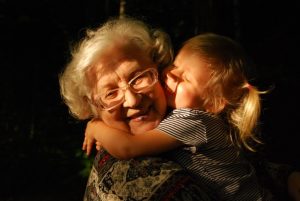
The degree of grandparent involvement depends on the proximity of the grandparents’ home to the grandchildren. In developed nations, greater societal mobility means that many grandparents live long distances from their grandchildren. Technology has brought grandparents and their more distant grandchildren together. Sorenson and Cooper (2010) found that many of the grandfathers they interviewed would text, email, or Skype with their grandchildren in order to stay in touch.
Cherlin and Furstenberg (1986) described three styles of grandparents. Thirty percent of grandparents were remote because they rarely saw their grandchildren. Usually they lived far away from the grandchildren but may also have had a distant relationship. Contact was typically made on special occasions, such as holidays or birthdays. Fifty-five percent of grandparents were described as companionate because they did things with their grandchildren but had little authority or control over them. They preferred to spend time with them without interfering in parenting. They were more like friends to their grandchildren. Fifteen percent of grandparents were described as involved because they took a very active role in their grandchild’s life. The involved grandparent had frequent contact with and authority over the grandchild, and their grandchildren might even live with them. Depending on the circumstances (which sometimes involve problems with the grandchildren’s parents, such as illness or addiction), taking over the parenting role for grandchildren can be stressful or it can be rewarding, or both. Grandmothers, more so than grandfathers, played this role. In contrast, more grandfathers than grandmothers saw their role as family historian and family advisor (Neugarten and Weinstein, 1964). Bengtson (2001) suggests that grandparents adopt different styles with different grandchildren, and over time may change styles as circumstances in the family change. Today more grandparents are the sole care providers for grandchildren or may step in at times of crisis.
Family Caregivers
A disabled child, spouse, parent, or other family member is part of the lives of some midlife adults. According to the National Alliance for Caregiving (2015), 40 million Americans provide unpaid caregiving for family members. The typical caregiver is a 49-year-old female currently caring for a 69 year-old female who needs care because of a long-term physical condition. Looking more closely at the age of the recipient of caregiving, the typical caregiver for those 18-49 years of age is a female (61%) caring mostly for her own child (32%) followed by a spouse or partner (17%). When looking at older recipients (50+) who receive care, the typical caregiver is female (60%) caring for a parent (47%) or spouse (10%).
Caregiving places an enormous burden on the caregiver, and is one of the most demanding and stressful roles that people can take on. Caregiving for a young or adult child with special needs is associated with poorer global health and more physical symptoms among both fathers and mothers (Seltzer, Floyd, Song, Greenberg, & Hong, 2011). Marital relationships are also a factor in how caregiving affects stress and chronic conditions. Fathers who were caregivers reported more chronic health conditions than non-caregiving fathers, regardless of marital quality. In contrast, caregiving mothers reported higher levels of chronic conditions when they also reported a high level of marital strain (Kang & Marks, 2014). Age can also make a difference in how one is affected by the stress of caring for a child with special needs. Using data from the Study of Midlife in the Unites States, Ha, Hong, Seltzer and Greenberg (2008) found that older parents were significantly less likely to experience the negative effects of having a disabled child than younger parents. They concluded that an age-related weakening of the stress occurred over time, as other non-disabled children became independent and left home. The general trend of greater emotional stability noted at midlife may also have played a role.
Currently 25% of adult children, mainly baby boomers, provide personal or financial care to a parent (Metlife, 2011). Daughters are more likely to provide basic care and sons are more likely to provide financial assistance. Adult children 50+ who work and provide care to a parent are more likely to have fair or poor health when compared to those who do not provide care. Some adult children choose to leave the work force to care for a parent, however, the cost of leaving the work force early is high. For females, lost wages and social security benefits equals $324,044, while for men it equals $283,716 (Metlife, 2011). This loss can jeopardize the adult child’s financial future. Consequently, there is a need for greater workplace flexibility for working caregivers.
Spousal Care. Certainly, caring for a disabled spouse can be a difficult experience that can negatively affect one’s health. However, research indicates that there can also be positive health effects for caring for a disabled spouse. Beach, Schulz, Yee and Jackson (2000) evaluated health related outcomes in four groups: Spouses with no caregiving needed (Group 1), living with a disabled spouse but not providing care (Group 2), living with a disabled spouse and providing care (Group 3), and helping a disabled spouse while reporting caregiver strain, including elevated levels of emotional and physical stress (Group 4). Not surprisingly, the participants in Group 4 were the least healthy and identified poorer perceived health, an increase in health-risk behaviors, and an increase in anxiety and depression symptoms. However, those in Group 3 who provided care for a spouse, but did not identify caregiver strain, actually reported decreased levels of anxiety and depression compared to Group 2 and were actually similar to those in Group 1. It appears that greater caregiving involvement was related to better mental health as long as the caregiving spouse did not feel strain. The beneficial effects of helping reported by the participants were consistent with previous research (Krause, Herzog, & Baker, 1992; Schulz et al., 1997).
When caring for a disabled spouse, gender differences have also been found. Female caregivers of a spouse with dementia experienced more burden, had poorer mental and physical health, exhibited increased depressive symptomatology, took part in fewer health-promoting activities, and received fewer hours of help than male caregivers (Gibbons et al., 2014). This study was consistent with previous research findings that women experience more caregiving burden than men, despite similar caregiving situations (Torti, Gwyther, Reed, Friedman, & Schulman, 2004; Yeager, Hyer, Hobbs, & Coyne, 2010). A primary factor contributing to women’s poorer caregiving outcomes is that disabled males are more aggressive than females, especially males with dementia who display more physical and sexual aggression toward their caregivers (Eastley & Wilcock, 1997; Zuidema, de Jonghe, Verhey, & Koopmans, 2009). Explanations for why women are not offered or do not use more external support, which may alleviate some of the burden, include society’s expectations that they should assume caregiving roles (Torti et al, 2004) and women’s concerns with the opinions of others (Arai, Sugiura, Miura, Washio, & Kudo, 2000). Female caregivers are certainly at risk for negative consequences of caregiving, and greater support needs to be available to them.
According to the Institute of Medicine (2015), it is estimated that 66 million Americans, or 29% of the adult population, are caregivers for someone who is dying or chronically ill. Two-thirds of these caregivers are women. This care takes its toll physically, emotionally, and financially. Family caregivers may face the physical challenges of lifting, dressing, feeding, bathing, and transporting a dying or ill family member. They may worry about whether they are performing all tasks safely and properly, as they receive little training or guidance. Such caregiving tasks may also interfere with their ability to take care of themselves and meet other family and workplace obligations. Financially, families often face high out of pocket expenses (IOM, 2015).
As can be seen in the table below, most family caregivers are providing care by themselves with little professional intervention, are employed, and have provided care for more than 3 years. In 2013, the annual loss of productivity in the U.S. was $25 billion as a result of work absenteeism due to providing this care. As the prevalence of chronic disease rises, the need for family caregivers is growing. Unfortunately, the number of potential family caregivers is declining as the large baby boomer generation enters into late adulthood (Redfoot, Feinberg, & Houser, 2013).
Table 8.5 Characteristics of family caregivers in the United States
| Characteristic | Percentages |
|---|---|
| No home visits by health care professionals | 69% |
| Caregivers are also employed | 72% |
| Duration of employed workers who have been caregiving for 3+ years | 55% |
| Caregivers for the elderly | 67% |
adapted from Lally & Valentine-French, 2019 and IOM, 2015
Friendships in Middle Adulthood
Adults of all ages who reported having a confidante or close friend with whom they could share personal feelings and concerns, believed these friends contributed to a sense of belonging, security, and overall wellbeing (Dunér & Nordstrom, 2007). Having a close friend is a factor in significantly lower odds of psychiatric morbidity including depression and anxiety (Harrison, Barrow, Gask, & Creed, 1999; Newton et al., 2008). The availability of a close friend has also been shown to lessen the adverse effects of stress on health (Kouzis & Eaton, 1998; Hawkley et al., 2008; Tower & Kasl, 1995). Additionally, poor social connectedness in adulthood is associated with a larger risk of premature mortality than cigarette smoking, obesity, and excessive alcohol use (Holt-Lunstad, Smith, & Layton, 2010).

Female friendships and social support networks at midlife contribute significantly to a woman’s feeling of life satisfaction and well-being (Borzumato-Gainey, Kennedy, McCabe, & Degges-White, 2009). Degges-White and Myers (2006) found that women who have supportive people in their lives experience greater life satisfaction than do those who live a more solitary life. A friendship network or the presence of a confidante have both been found to be important to women’s mental health (Baruch & Brooks-Gunn, 1984). Unfortunately, with numerous caretaking responsibilities at home, it may be difficult for women to find time and energy to enhance the friendships that would provide an increased sense of life satisfaction (Borzumato-Gainey et al., 2009). Emslie, Hunt and Lyons (2013) found that for men in midlife, the shared consumption of alcohol was important to creating and maintaining male friends. Drinking with friends was justified as a way for men to talk to each other, provide social support, relax, and improve mood. Although the social support provided when men drink together can be helpful, the role of alcohol in male friendships can lead to health damaging behavior from excessive drinking.
The importance of social relationships begins in early adulthood by laying down a foundation for strong social connectedness and facilitating comfort with intimacy (Erikson, 1959). To determine the impact of the quantity and quality of social relationships in young adulthood on middle adulthood, Carmichael, Reis, and Duberstein (2015) assessed individuals at age 50 on measures of social connection (types of relationships and friendship quality) and psychological outcomes (loneliness, depression, psychological well-being). Results indicated that the quantity of social interactions at age 20 and the quality, but not quantity, of social interaction at age 30 predicted midlife social interactions. Those individuals who had high levels of social information seeking (quantity) at age 20 followed by fewer social relationships but greater emotional closeness (quality), ended up showing the most positive psychosocial adjustment at midlife.
References
AARP. (2009). The divorce experience: A study of divorce at midlife and beyond. Washington, DC: AARP
Ahlborg, T., Misvaer, N., & Möller, A. (2009). Perception of marital quality by parents with small children: A follow-up study when the firstborn is 4 years old. Journal of Family Nursing, 15, 237–263.
Allendorf, K. (2013). Schemas of marital change: From arranged marriages to eloping for love. Journal of Marriage and Family, 75, 453-469.
Alterovitz, S. S., & Mendelsohn, G. A. (2013). Relationship goals of middle-aged, young-old, and old-old Internet daters: An analysis of online personal ads. Journal of Aging Studies, 27, 159–165.
Anderson, E. R., & Greene, S. M. (2011). “My child and I are a package deal”: Balancing adult and child concerns in repartnering after divorce. Journal of Family Psychology, 25(5), 741-750.
Anderson, E.R., Greene, S.M., Walker, L., Malerba, C.A., Forgatch, M.S., & DeGarmo, D.S. (2004). Ready to take a chance again: Transitions into dating among divorced parents. Journal of Divorce and Remarriage, 40, 61-75.
Aquilino, W. (1991). Predicting parents’ experiences with coresidence adult children. Journal of Family Issues, 12(3), 323-342.
Arai, Y., Sugiura, M., Miura, H., Washio, M., & Kudo, K. (2000). Undue concern for other’s opinions deters caregivers of impaired elderly from using public services in rural Japan. International Journal of Geriatric Psychiatry, 15(10), 961-968.
Beach, S. R., Schulz, R., Yee, J. L., & Jackson, S. (2000). Negative and positive health effects of caring for a disabled spouse: Longitudinal findings from the caregiver health effects study. Psychology and Aging, 15(2), 259-271.
Belsky, J. (1984). The determinants of parenting: A process model. Child Development, 55, 83–96.
Bengtson, V. L. (2001). Families, intergenerational relationships, and kinkeeping in midlife. In N. M. Putney (Author) & M. E. Lachman (Ed.), Handbook of midlife development (pp. 528-579). New York: Wiley.
Benokraitis, N. V. (2005). Marriages and families: Changes, choices, and constraints (5th ed.). Upper Saddle River, NJ: Pearson.
Birditt, K. S., & Antonucci, T.C. (2012). Till death do us part: Contexts and implications of marriage, divorce, and remarriage across adulthood. Research in Human Development, 9(2), 103-105.
Borland, D. C. (1982). A cohort analysis approach to the empty-nest syndrome among three ethnic groups of women: A theoretical position. Journal of Marriage and the Family, 44, 117–129.
Bouchard, G. (2013). How do parents reaction when their children leave home: An integrative review. Journal of Adult Development, 21, 69-79.
Bronfenbrenner, U. (1989). Ecological systems theory. In R. Vasta (Ed.), Annals of Child Development, Vol. 6 (pp. 187–251). Greenwich, CT: JAI Press.
Brown, S. L., & Lin, I. (2013). The gray divorce revolution: Rising divorce among middle aged and older adults 1990-2010. National Center for Family & Marriage Research Working Paper Series. Bowling Green State University. https://www.bgsu.edu/content/dam/BGSU/college-of-arts-and- sciences/NCFMR/ documents/Lin/The-Gray-Divorce.pdf
Bumpass, L. L. (1990). What’s happening to the family? Interactions between demographic and institutional change. Demography, 27(4), 483–498.
Carmichael, C. L., Reis, H. T., & Duberstein, P. R. (2015). In your 20s it’s quantity, in your 30s it’s quality: The prognostic value of social activity across 30 years of adulthood. Psychology and Aging, 30(1), 95-105.
Centers for Disease Control and Prevention (2015a). Births and natality. Retrieved from http://www.cdc.gov/nchs/fastats/births.htm
Cherlin, A. J., & Furstenberg, F. F. (1986). The new American grandparent: A place in the family, a life apart. New York: Basic Books.
Clark, L. A., Kochanska, G., & Ready, R. (2000). Mothers’ personality and its interaction with child temperament as predictors of parenting behavior. Journal of Personality and Social Psychology, 79, 274–285.
Cohen, P. (2013). Marriage is declining globally. Can you say that? Retrieved from https://familyinequality.wordpress.com/2013/06/12/marriage-is-declining/
Cohn, D. (2013). In Canada, most babies now born to women 30 and older. Pew Research Center.
Conger, R. D., & Conger, K. J. (2002). Resilience in Midwestern families: Selected findings from the first decade of a prospective longitudinal study. Journal of Marriage and Family, 64, 361–373.
Cooke, L. P. (2010). The politics of housework. In J. Treas & S.Drobnic (Eds.), Dividing the domestic: Men, women, and household work in cross-national perspective (pp. 59-78). Standford, CA: Stanford University Press.
Copen, C.E., Daniels, K., & Mosher, W.D. (2013) First premarital cohabitation in the United States: 2006–2010 National Survey of Family Growth. National health statistics reports; no 64. Hyattsville, MD: National Center for Health Statistics.
Crowley, K., Callanan, M. A., Tenenbaum, H. R., & Allen, E. (2001). Parents explain more often to boys than to girls during shared scientific thinking. Psychological Science, 12, 258–261.
Demick, J. (1999). Parental development: Problem, theory, method, and practice. In R. L. Mosher, D. J. Youngman, & J. M. Day (Eds.), Human development across the life span: Educational and psychological applications (pp. 177–199). Westport, CT: Praeger.
Dennerstein, L., Dudley, E., & Guthrie, J. (2002). Empty nest or revolving door? A prospective study of women’s quality of life in midlife during the phase of children leaving and re-entering the home. Psychological Medicine, 32, 545–550.
DePaulo, B. (2014). A singles studies perspective on mount marriage. Psychological Inquiry, 25(1), 64-68.
Desai, S., & Andrist, L. (2010). Gender scripts and age at marriage in India. Demography, 47, 667-687.
Desilver, D. (2016). In the U. S. and abroad, more young adults are living with their parents. Retrieved from: https://www.pewresearch.org/fact-tank/2016/05/24/in-the-u-s-and-abroad-more-young-adults-are-living-with-their-parents/
Dye, J. L. (2010). Fertility of American women: 2008. Current Population Reports. Retrieved from www.census.gov/prod/2010pubs/p20-563.pdf.
Eastley, R., & Wilcock, G. K. (1997). Prevalence and correlates of aggressive behaviors occurring in patients with Alzheimer’s disease. International Journal of Geriatric Psychiatry, 12, 484-487.
Eisenberg, N., Fabes, R. A., Shepard, S. A., Guthrie, I.K., Murphy, B.C., & Reiser, M. (1999). Parental reactions to children’s negative emotions: Longitudinal relations to quality of children’s social functioning. Child Development, 70, 513-534.
Eisenberg, N., Hofer, C., Spinrad, T., Gershoff, E., Valiente, C., Losoya, S. L., Zhou, Q., Cumberland, A., Liew, J., Reiser, M., & Maxon, E. (2008). Understanding parent-adolescent conflict discussions: Concurrent and across-time prediction from youths’ dispositions and parenting. Monographs of the Society for Research in Child Development, 73, (Serial No. 290, No. 2), 1-160.
Emslie, C., Hunt, K., & Lyons, A. (2013. The role of alcohol in forging and maintaining friendships amongst Scottish men in midlife. Health Psychology, 32(10, 33-41.
Erikson, E. (1950). Childhood and society. New York: Norton & Company.
Erikson, E. (1959). Identity and the life cycle. New York: Norton & Company.
Erikson, E. (1982). The life cycle completed. New York: Norton & Company.
Fehr, B. (2008). Friendship formation. In S. Sprecher, A. Wenzel, & J. Harvey (Eds.), Handbook of Relationship Initiation (pp. 29–54). New York, NY: Psychology Press.
Gibbons, C., Creese, J., Tran, M., Brazil, K., Chambers, L., Weaver, B., & Bedard, M. (2014). The psychological and health consequences of caring for a spouse with dementia: A critical comparison of husbands and wives. Journal of Women & Aging, 26, 3-21.
Goldscheider, F., & Kaufman, G. (2006). Willingness to stepparent: Attitudes about partners who already have children. Journal of Family Issues, 27, 1415 – 1436.
Goldscheider, F., & Sassler, S. (2006). Creating stepfamilies: Integrating children into the study of union formation. Journal of Marriage and Family, 68, 275 – 291.
Gonzales, N. A., Coxe, S., Roosa, M. W., White, R. M. B., Knight, G. P., Zeiders, K. H., & Saenz, D. (2011). Economic hardship, neighborhood context, and parenting: Prospective effects on Mexican-American adolescent’s mental health. American Journal of Community Psychology, 47, 98–113.
Gorchoff, S. M., John, O. P., & Helson, R. (2008). Contextualizing change in marital satisfaction during middle age. Psychological Science, 19, 1194–1200.
Gottman, J. M., & Levenson, R. W. (2000). The timing of divorce: Predicting when a couple will divorce over a 14-year period. Journal of Marriage & the Family, 62, 737-745.
Greene, S. M., Anderson, E. R., Hetherington, E., Forgtch, M. S., & DeGarmo, D. S. (2003). Risk and resilience after divorce. In F. Walsh (Ed.), Normal family processes: Growing diversity and complexity (3rd ed., pp. 96-120). New York: Guilford Press.
Greenfield, E. A., & Marks, N. F. (2006). Linked lives: Adult children’s problems and their parents’ psychological and relational well-being. Journal of Marriage and Family, 68, 442-454.
Grusec, J. E., Goodnow, J. J., & Cohen, L. (1996). Household work and the development of concern for others. Developmental Psychology, 32, 999–1007.
Gurrentz, B. (2018). For young adults, cohabitation is up, and marriage is down. US. Census Bureau. Retrieved from https://www.census.gov/library/stories/2018/11/cohabitaiton-is-up-marriage-is-down-for-young-adults.html.
Ha, J., Hong, J., Seltzer, M. M., & Greenberg, J. S. (2008). Age and gender differences in the well-being of midlife and aging parents with children with mental health or developmental problems: Report of a national study. Journal of Health and Social Behavior, 49, 301-316.
Hamilton, B. E., Martin, J. A., & Ventura, S. J. (2011). Births: Preliminary data for 2010. National Vital Statistics Reports, 60(2). Hyattsville, MD: U.S. Department of Health and Human Services.
Hawkley, L. C., Hughes, M. E., Waite, L. J., Masi, C. M., Thisted, R. A., & Cacioppo, J. T. (2008). From social structural factors to perceptions of relationship quality and loneliness: The Chicago health, aging, and marital status transitions and health outcomes social relations study. The Journals of Gerontology: Series B: Psychological Sciences and Social Sciences, 63, 375–384.
Hayslip Jr., B., Henderson, C. E., & Shore, R. J. (2003). The Structure of Grandparental Role Meaning. Journal of Adult Development, 10(1), 1-13.
Hetherington, E. M. & Kelly, J. (2002). For better or worse: Divorce reconsidered. New York, NY: Norton.
Holt-Lunstad, J., Smith, T. B., & Layton, J. B. (2010). Social relationships and mortality risk: a meta-analytic review. PLoS Medicine, 7(7), e1000316.
Hyde, J. S., Else-Quest, N. M., & Goldsmith, H. H. (2004). Children’s temperament and behavior problems predict their employed mothers’ work functioning. Child Development, 75, 580–594.
Institute of Medicine. (2015). Dying in America: Improving quality and honoring individual preferences near end of life. Washington, DC: The National Academies Press.
Kang, S. W., & Marks, N. F. (2014). Parental caregiving for a child with special needs, marital strain, and physical health: Evidence from National Survey of Midlife in the U.S. 2005. Contemporary Perspectives in Family Research, 8A, 183-209.
Kerr, D. C. R., Capaldi, D. M., Pears, K. C., & Owen, L. D. (2009). A prospective three generational study of fathers’ constructive parenting: Influences from family of origin, adolescent adjustment, and offspring temperament. Developmental Psychology, 45, 1257–1275.
Kiff, C. J., Lengua, L. J., & Zalewski, M. (2011). Nature and nurturing: Parenting in the context of child temperament. Clinical Child and Family Psychology Review, 14, 251–301.
Krause, N. A., Herzog, R., & Baker, E. (1992). Providing support to others and well-being in later life. Journal of Gerontology: Psychological Sciences, 47, P300-311.
Lachman, M. E. (2004). Development in midlife. Annual Review of Psychology, 55(1), 305-331.
Landsford, J. E., Antonucci, T.C., Akiyama, H., & Takahashi, K. (2005). A quantitative and qualitative approach to social relationships and well-being in the United States and Japan. Journal of Comparative Family Studies, 36, 1-22.
Lesthaeghe, R. J., & Surkyn, J. (1988). Cultural dynamics and economic theories of fertility change. Population and Development Review 14(1), 1–45.
Livingston, G. (2014). Four in ten couples are saying I do again. In Chapter 3. The differing demographic profiles of first-time marries, remarried and divorced adults. Pew Research Center. Retrieved from http://www.pewsocialtrends.org/2014/11/14/chapter-3-the-differing-demographic-profiles-of-first-time-married-remarried-and-divorced-adults/
Lucas, R. E. & Donnellan, A. B. (2011). Personality development across the life span: Longitudinal analyses with a national sample from Germany. Journal of Personality and Social Psychology, 101, 847–861
Martinez, G., Daniels, K., & Chandra, A. (2012). Fertility of men and women aged 15-44 years in the United States: National Survey of Family Growth, 2006-2010. National Health Statistics Reports, 51(April). Hyattsville, MD: U.S., Department of Health and Human Services.
Metlife. (2011). Metlife study of caregiving costs to working caregivers: Double jeopardy for baby boomers caring for their parents. Retrieved from http://www.caregiving.org/wp-content/uploads/2011/06/mmi-caregiving-costs-working-caregivers.pdf
Mitchell, B. A., & Lovegreen, L. D. (2009). The empty nest syndrome in midlife families: A multimethod exploration of parental gender differences and cultural dynamics. Journal of Family Issues, 30, 1651–1670.
Montenegro, X. P. (2003). Lifestyles, dating, and romance: A study of midlife singles. Washington, DC: AARP.
National Alliance for Caregiving. (2015). Caregiving in the U.S. 2015. Retrieved from http://www.caregiving.org/caregiving2015.
Neugarten, B. L., & Weinstein, K. K. (1964). The changing American grandparent. Journal of Marriage and the Family, 26, 199–204.
Newton, T., Buckley, A., Zurlage, M., Mitchell, C., Shaw, A., & Woodruff-Borden, J. (2008). Lack of a close confidant: Prevalence and correlates in a medically underserved primary care sample. Psychology, Health & Medicine, 13, 185–192.
Parker, K. & Patten, E. (2013). The sandwich generation: Rising financial burdens for middle-aged Americans. Pew Research Center. Retrieved from http://www.pewsocialtrends.org/2013/01/30/the-sandwich-generation/
Payne, K. K. (2015). The remarriage rate: Geographic variation, 2013. National Center for Family & Marriage Research. Retrieved from http://bgsu.edu/ncfmr/resources/data/family-profiles/payne-remarriage-rate-fp-15-08.html
Pew Research Center. (2010). The return of the multi-generational family household. Retrieved from http://www.pewsocialtrends.org/2010/03/18/the-return-of-the-multi-generational-family-household/
Pew Research Center. (2010a). How the great recession has changed life in America. Retrieved from http://www.pewsocialtrends.org/2010/06/30/how-the-great-recession-has-changed-life-in-america/
Pew Research Center. (2010b). Section 5: Generations and the great recession. Retrieved from http://www.people-press.org/2011/11/03/section-5-generations-and-the-great-recession/
Pew Research Center. (2015). Caring for aging parents. Family support in graying societies. Retrieved from http://www.pewsocialtrends.org/2015/05/21/4-caring-for-aging-parents/
Pew Research Center. (2019). Same-sex marriage around the world. Retrieved from https://www.pewforum.org/fact-sheet/gay-marriage-around-the-world/
Prinzie, P., Stams, G. J., Dekovic, M., Reijntjes, A. H., & Belsky, J. (2009). The relations between parents’ Big Five personality factors and parenting: A meta-review. Journal of Personality and Social Psychology, 97, 351–362.
Proulx, C. M., Helms, H. M., & Buehler, C. (2007). Marital Quality and Personal Well-Being: A Meta-Analysis. Journal of Marriage and Family, 69(3), 576–593
Saginak, K. A., & Saginak, M. A. (2005). Balancing work and family: Equity, gender, and marital satisfaction. Counseling and Therapy for Couples and Families, 13, 162-166.
Sandberg-Thoma, S. E., Synder, A. R., & Jang, B. J. (2015). Exiting and returning to the parental home for boomerang kids. Journal of Marriage and Family, 77, 806-818.
Schulz, R., Newsom, J., Mittelmark, M., Burton, L., Hirsch, C., & Jackson, S. (1997). Health effects of caregiving: The caregiver health effects study. Annals of Behavioral Medicine, 19, 110-116.
Seccombe, K., & Warner, R. L. (2004). Marriages and families: Relationships in social context. Belmont, CA: Wadsworth/Thomson Learning.
Seltzer, M. M., Floyd, F., Song, J., Greenberg, J., & Hong, J. (2011). Midlife and aging parents of adults with intellectual and developmental disabilities: Impacts of lifelong parenting. American Association on Intellectual and Developmental Disability, 116, 479-499.
Stewart, S. D., Manning, W. D., & Smock, P. J. (2003). Union formation among men in the US: Does having prior children matter? Journal of Marriage and Family, 65, 90 – 104.
Tamis-LeMonda, C. S., Way, N., Hughes, D., Yoshikawa, H., Kalman, R. K., & Niwa, E. Y. (2008). Parents’ goals for children: The dynamic coexistence of individualism and collectivism in cultures and individuals. Social Development, 17, 183–209.
Teachman, J. (2008). Complex life course patterns and the risk of divorce in second marriages. Journal of Marriage and Family, 70, 294 – 305.
Thornton, A. (2005). Reading history sideways: The fallacy and enduring impact of the developmental paradigm on family life. Chicago: University of Chicago Press.
Torti, F. M., Gwyther, L. P., Reed, S. D., Friedman, J. Y., & Schulman, K. A. (2004). A multinational review of recent trends and reports in dementia caregiver burden. Alzheimer Disease and Associated Disorders, 18(2), 99-109.
Umberson, D., Williams, K., Powers, D., Chen, M., & Campbell, A. (2005). As good as it gets? A life course perspective on marital quality. Social Forces, 81, 493-511.
Wang, W., & Parker, K. (2014). Record share of Americans have never married: As values, economics and gender patterns change. Washington, DC: Pew Research Center. http://www.pewsocialtrends.org/files/2014/09/2014-09-24_Never-Married-Americans.pdf
Wang, W., & Taylor, P. (2011). For Millennials, parenthood trumps marriage. Washington, DC: Pew Research Center.
Williams, L., Kabamalan, M., & Ogena, N. (2007). Cohabitation in the Philippines: Attitudes and behaviors among young women and men. Journal of Marriage and Family, 69(5), 1244–1256.
Witt, J. (2009). SOC. New York: McGraw Hill.
Wu, Z., Sun, L., Sun, Y., Zhang, X., Tao, F., & Cui, G. (2010). Correlation between loneliness and social relationship among empty nest elderly in Anhui rural area, China. Aging and Mental Health, 14, 108–112.
Yeager, C. A., Hyer, L. A., Hobbs, B., & Coyne, A. C., (2010). Alzheimer’s disease and vascular dementia: The complex relationship between diagnosis and caregiver burden. Issues in Mental Health Nursing, 31(6), 376-384.
Yu, J., & Xie, Y. (2015). Cohabitation in China: Trends and determinants. Population & Development Review, 41 (4), 607-628.
Zuidema, S. U., de Jonghe, J. F., Verhey, F. R., & Koopman, R. T. (2009). Predictors of neuropsychiatric symptoms in nursing home patients: Influence of gender and dementia severity. International Journal of Geriatric Psychiatry, 24(10), 1079-1086.
“Lifespan Development: A Psychological Perspective, Second Edition” by Martha Lally and Suzanne Valentine-French is licensed under a CC-BY-NC-SA-3.0/modified (new introduction text) by Dan Grimes, Portland State University
Lifespan Development by Lumen Learning is licensed under a Creative Commons Attribution 4.0 International License
Media Attributions
- cohab1 © US Census Bureau is licensed under a Public Domain license
- cohab2 © US Census Bureau is licensed under a Public Domain license
- maritalstatus © Pew Research Center
- in-lieu-in-view-photography-lj3BEGiZ2fw-unsplash-2 © In Lieu In View Photography is licensed under a CC0 (Creative Commons Zero) license
- eye-for-ebony-zQQ6Y5_RtHE-unsplash-2 © Eye for Ebony is licensed under a CC0 (Creative Commons Zero) license
- influences parenting © Marissa L. Diener is licensed under a CC BY-NC-SA (Attribution NonCommercial ShareAlike) license
- sandwichgen © Pew Research Center
- finanacialstrain © Pew Research Center
- FT_17.05.03_livingAtHome_byGen2 © Pew Research Center
- FT_16.05.20_livingWithParents_Europe © Pew Research Center
- agemaritalstatus © Pew Research Center
- ST_2014-11-14_remarriage-06 © Pew Research Center is licensed under a All Rights Reserved license
- anthony-tran-rvdlDB1D68c-unsplash © Anthony Tran is licensed under a CC0 (Creative Commons Zero) license
- jude-beck-a-nWU0o73r4-unsplash © Jude Beck is licensed under a CC0 (Creative Commons Zero) license
- ekaterina-shakharova-L4nwL3195U0-unsplash © Ekaterina Shakharova is licensed under a CC0 (Creative Commons Zero) license
- o-OLD-WOMEN-BEST-FRIENDS-facebook

